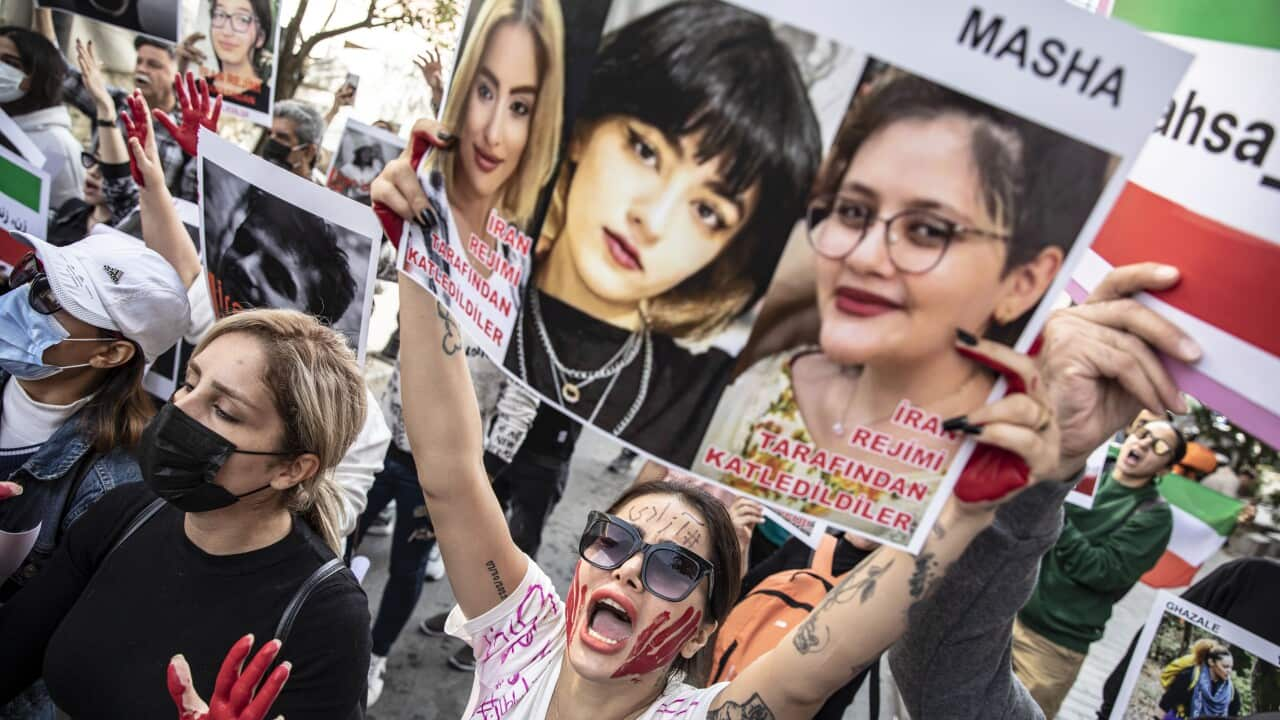Key points
- Saudi-Australian activist Manal Al-Sharif supports protests by women in Iran against the imposition of wearing the hijab
- She moved to Australia in 2017 after years of defending women's freedom and rights in Saudi Arabia
- Human rights lawyer Sara Saleh backs the view that the decision to wear the hijab should be left up to the individual
Saudi-Australian activist Manal Al-Sharif tells SBS Arabic24 that she “stands with” those demonstrating against laws that force women to wear the hijab in Iran, protests that have been gaining momentum following the death of 22-year-old Mahsa Amini.
Ms Amini was arrested in Tehran on September 13 on the pretext that she was not wearing the hijab appropriately.
Her death was followed by mass protests in the Islamic Republic over a range of issues including perceived police abuses and the poor state of the economy following years of crippling US sanctions.
The protests have resulted in the deaths of dozens of people, including members of the security forces, as authorities blame “troublemakers” for the unrest.
Despite the use of deadly force by the security forces, demonstrations led by both women and men have continued.
Iran is among a handful of countries that impose the wearing of the hijab and other face coverings.
The 1979 Islamic revolution introduced the idea of hijab law, and wearing the garment became obligatory for all Iranian women from April 1983.
Since then, all women have been legally obliged to wear hijab in public, even non-Muslims and foreigners visiting Iran.
Ms Al-Sharif says the Iranian unrest reminds her of her own experiences in Saudi Arabia, and her decision to remove the hijab.
“The morality police [in Saudi Arabia] used to impose on us certain clothes, a certain colour, a certain way to wear the hijab, and failure to comply meant facing punishment," she says.
“Even men cannot wear shorts in Saudi Arabia.”
She believes that the decision to wear the hijab “should be left up to the woman”, adding that her "heart" is with Iranian women in the face of the “brutality” they are subjected to.
[A woman’s] worship is between her and Allah. It is not obligatory to impose hijab or prevent hijab. For me, both things are a blatant interference in people's personal freedoms, freedom of worship and freedom of choice.Manal Al-Sharif
Ms Al-Sharif says she “had no choice” but to wear the hijab from an early age.
“The hijab was imposed on me when I was in primary school and then the abaya was in middle school,” she says.
“The authority's censorship was very tight. I will not forget the time I was visiting Mecca wearing a burqa and walking around the Masjid al-Haram (Great Mosque of Mecca) when one of the members of the Authority (Al-Mutawa) told me to cover my eyes.”
Grand Mufti of Australia, Ibrahim Abu Mohammed, says linguistically, the word "hijab" means a cover or barrier and is a way for women to show their devotion to their lord.
“Hijab in Islam is for a woman to cover her entire body except for the face and hands. Hence, it is a duty that Muslim women are bound by within the code of Islamic Law (shari’ah)," Mr Abu Mohammed said.
Although wearing the hijab is considered an obligation for Muslim women, the Grand Mufti explains that no one has the right to force any kind of clothing on women.

Grand Mufti of Australia Ibrahim Abu Mohammed Source: AAP
"A woman's wearing of the hijab is seen as a manifestation of the fulfilment of an obligation upon Muslim women, to honour and protect her, but not for her to be coerced into wearing the hijab."
He says that this is because faith (‘Iman’) is the voluntary submissiveness of the inner heart, so coercion in any form cannot be applied. Islam is a religion that has relied upon reason to dialogue and did not rely on force, oppression, and compulsion to dominate or prevail.
“Therefore, the Islamic worldview is that a person should be consistent with his or her own self, both outwardly and inwardly, so that they do not come to believe in anything inwardly, whilst contradicting this belief outwardly through contrary practice and behaviour," Mr Abu Mohammed said.
“The religion of Islam seeks the human being to be reconciled both outwardly and inwardly.”
"The Muslim woman must remember that she has accepted Islam as a complete way of life. In accordance with her Islamic faith, she follows and has accepted Islam as an entire system," Mr Abu Mohammed added.

Manal Al Sharif
Hair-cutting and shaving, a ‘valid form of protest'
Images and videos of women shaving their heads to protest Iran’s hijab laws have gone viral on social media.
Regarding the phenomenon, Ms Al-Sharif believes that it is a “valid form of protest” used for a number of reasons.
She was one of many Saudi women activists who shaved their heads to protest the imprisonment of fellow protesters who had demanded their rights as part of the 'my right is my dignity' campaign in 2012.
“We heard that the head of one of the prisoners was shaved, and, in solidarity with her, I and many other Saudi women, shaved our heads. But later we learned from her family that she was electrocuted, which caused her hair to fall out,” Ms Al-Sharif explains.
“[Shaving our heads] was a spontaneous decision. But it is definitely a powerful way to protest what hair on the head means to women.”
Campaign for women drivers
Ms Al-Sharif is most famous for leading a campaign demanding women's driving rights in response to social restrictions that prevented women from driving a car in Saudi Arabia.
She contributed to the launch of the ‘I will drive my car myself’ initiative in 2011.
Activist, Wjiha Al-Huwaider, recorded videos of Ms Al-Sharif driving as part of the campaign which was later posted on YouTube and Facebook.
The New York Times and the Associated Press attributed Ms Al-Sharif's campaign to the biggest issue of the so-called Arab Spring protests, as well as the long period in which she was detained amid fears of further public disruptions by the Saudi authorities.
She believes the existence of the internet has led to a digital “information revolution”, opening up platforms to express different opinions that were previously hidden.
“I started reading on the Internet about the subject of hijab. I found many different and conflicting opinions," Ms Al-Sharif says.
"Some of them say that there is no religious text in the Qur'an that requires hijab while others say the opposite is true. I read different perspectives on face coverings as well."
She believes there was a "war" being waged on women's bodies with the hijab enforced in some countries such as Indonesia, Afghanistan and most of Saudi Arabia while forbidden in others such as France and Tunisia.
.jpeg?imwidth=1280)
Manal Al-Sharif has campaigned for women's rights in Saudi Arabia for many years
“The obligation of hijab has been specified in established and accepted primary sources of legislation within the Islamic law system, including Surah al-Nur and Surah al-Ahzab (two chapters of the Holy Quran), as well as in the sound traditions (sunnah) of the Prophet Muhammad, peace be upon him,” Mr Abu Mohammed says.
Ms Al-Sharif says that the battle to “have freedom” over when and where she wore her hijab took 10 years and until she migrated to Australia on a skilled worker visa in 2017
“I had to leave Saudi Arabia. I feel free. I can post my pictures without a veil at last,” she said.
she believes that the only solution for overcoming repressive regimes is to stand up against them and raise voices because dialogue alone is useless as they are not democratic systems.
“Certainly, women who still live in these countries suffer significant losses from these regimes including imprisonment, intimidation, dismissal from work, ostracisation from their families and children, and marriage termination," she says.
“When I left Saudi Arabia, I had more power to raise my voice. Unfortunately, this means that I will not be able to return to my country ever again."
She is "incredibly sad" that she has not been able to enter Saudi Arabia again to see her family members and childhood friends.

Sara Saleh Credit: SA
'I choose to wear the hijab'
Ms Al-Sharif's view that wearing the hijab should be a personal decision has been echoed by Sydney-based human rights lawyer, campaigner for racial justice, writer and poet, Sara Saleh.
Ms Saleh is the daughter of migrants from Egypt, Lebanon, and Palestine.
“I see hijab as part of my identity as a Muslim woman, but I don't reduce my whole self to it," Ms Saleh says.
She began wearing the hijab in 2014, a decision that she embraced.
"For me, it's an outward expression of the inward, a ritual, a reminder, and an important thread - as part of a wider fabric - that continuously ties me to my deen (religion)," she says.
“We know the hijab, the way we dress and our bodies have long been battlegrounds for surveillance, power, commodification, colonisation, and state control.Sara Saleh
“One way or another, we are being exploited and extracted, so for me, choosing to wear hijab is one powerful way to set my boundaries and figure out how to navigate and exist in these oppressive systems.
“Ultimately, I refuse to let our bodies and what we choose to wear or not wear be the way a society or state measures morality or progress or freedom.”
READ MORE

What is Burqa, Niqab and Hijab?
You can listen to the full interview with activist Manal Al-Sharif via the audio link attached above.
You can also listen to our programs via or through the SBS Radio app, which is available free of charge on
. You can also watch news anytime on SBS On Demand





